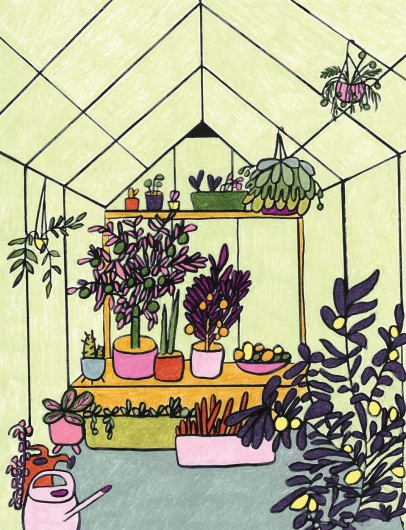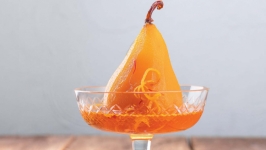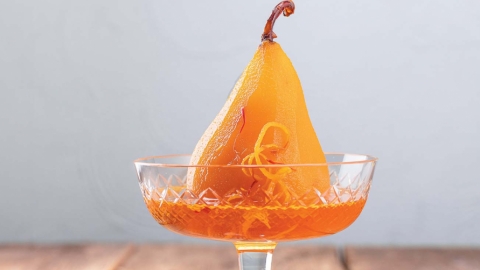Citrus For All Seasons
My passion for teaching people how to grow food ignited with the realization I could grow a lime tree in the middle of Indiana. It taught me we are not tied to our USDA Hardiness Zone, but to our own imagination. The zone suggests limits on what we can grow in traditional ways, but does not account for creativity, ingenuity, perseverance and microclimates.
History tells us humans started experimenting with expanding their zone almost 2,000 years ago. The first climate-controlled structure was created in Rome in the year 30 CE to grow cucumbers year-round for the emperor, Tiberius. It utilized stone walls and a translucent ceiling.
During the 17th century in Europe, a glass-walled structure called an orangery became popular with the wealthy. Orangeries were first constructed to grow plants native to warmer growing zones. Today, orangeries are used less for growing and more for bridging the space between home and garden.
Don’t have an orangery? Not to worry. Here is a simple guide to growing your favorite citrus in any space.
THINK OUTSIDE THE ZONE
The USDA Hardiness Zone is a standard farmers and gardeners can use to determine which plants are most likely to thrive planted outdoors in a specific area. Indiana has four growing zones: 5b, 6a, 6b and 7a.
A growing zone is just a guideline and can be broken with a little creativity and planning. Citrus can grow outside of subtropical and tropical regions (USDA Zones 10 and 11) under the right conditions. Although you can grow most inside year-round, I recommend moving them outside as soon as possible: My citrus trees experience the most growth when they are exposed to the outdoor summer conditions of wind, rain and natural sunlight.
When the temperature is below 50, citrus should be brought indoors and placed near a south-facing window that receives 8–12 hours of direct sunlight and is free of drafts. If you do not have a window with good southern exposure, you can substitute with a full-spectrum grow light for 12–16 hours per day. In the warmer months, when the temperature is consistently above 50 during both day and night, it can be placed outside in a space with full to partial sun exposure.
The citrus that has been productive for me year over year is the Bearss lime (Citrus x latifolia). It is a semi-dwarf Persian lime that produces fruit year-round, which makes it a great choice for growing inside your home, on a balcony or lining your favorite path in your landscape—during the warmer months, of course!
Other citrus trees that make great potted additions to your home are calamondin (Citrus x mitis) and Meyer lemon (Citrus x meyeri). Calamondins are a cross between a kumquat and a tangerine. They resemble small tangerines and will typically have four or five fruiting periods during each year. Meyer lemons are a sweeter and juicier lemon hybrid and are a cross between a lemon tree and a mandarin tree.
Regardless of which citrus you choose to grow, you will be entranced by the fragrant flowers and delicious flavors of homegrown citrus. You will never look at store-bought citrus the same way again.
LOCAL RESOURCES
Habig Garden Shop
Westfield & Indianapolis
HabigGardenShop.weebly.com
Allisonville Home and Garden by Sullivan
AllisonvilleGarden.com
Sullivan Hardware and Garden
SullivanHardware.com
If you can’t find citrus trees at your local garden store, my favorite online source is Four Winds Growers: FourWindsGrowers.com
PEACEFUL & PRACTICAL EDIBLE GARDENS
was born from the combined love of gardening, food and design.
Founded by Lynsey Johnston, P&P reimagines how we source our food, while maintaining beautiful and bountiful landscapes. Lynsey is fascinated by the possibility that food can grow anywhere, that a few seeds can provide enough food for multiple families and that a deeper understanding of plants and nature has the power to change our lives.
P&P is active in the community, teaching folks how to responsibly create and care for their gardens, build spaces and grow healthy food. They have a keen focus on caring for the earth, centering ethical principles of permaculture and educating the community. P&P works with home gardeners and community gardens in the Indianapolis area, and serves clients on a national scale through virtual support. Their services include edible garden design, installation and maintenance, and workshops and coaching.
Do you want to reconnect with nature and redesign your space, while growing your own healthy food?
Learn more at PeacefulAndPracticalEdibleGardens.com
Follow on Instagram @peacefulpracticalediblegardens
And in case you are wondering: Yes, lime trees can grow in Central Indiana.
MATERIALS LIST
Citrus soil blend
Perlite
Organic citrus fertilizer
Small paintbrush
Container with drainage
Grow lights: T5 fluorescent bulbs in the 6500k color temperature
POTTING CITRUS
Choose a container with multiple drainage holes.
Containers should be 10–14 inches for young trees. Any larger will make it difficult to control moisture levels.
Add perlite to the bottom of the container and mix with the citrus soil blend.
Unwind any roots, place in the container and add the soil blend no higher than the current soil level of the plant you received.
PEST MANAGEMENT
Observation is key for pest management. Reduce the risk of losing your citrus to pests by taking time to give it a good once-over every week. Look for pests on the stems, trunk, branch, tops and bottoms of leaves.
Common pests are mealybugs, scale and sooty mold.
Ants are an indicator species. If you see ants on your tree, most likely you have one of the above pests.
When you need help with managing pests, Arbico Organics is a great resource. They will recommend the best products for the situation. (Arbico-Organics.com)
CARE TIPS
Water thoroughly only when the top inch of the soil is dry.
Let dry out in between waterings.
Humidity is important. Place a tray filled with pebbles and water near the tree or mist the foliage when indoors during the winter months.
Fertilize weekly spring through fall.
Gently wipe off leaves when dust accumulates during the indoor growing season.
Hand pollination is necessary during the indoor growing season. Using a small paintbrush to move pollen from one flower to another is an easy way to pollinate.







